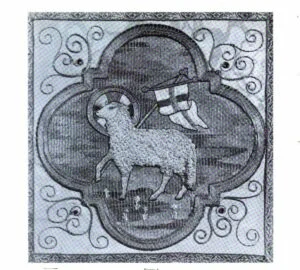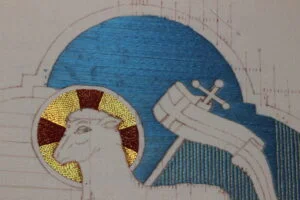Goldwork Embroidery and Meandering Thoughts
Goldwork Embroidery and Meandering Thoughts
A small amount of stitching has been added to the Easter Set Pulpit Fall. The amount is almost not worth mentioning at this point, except for the fact that it is a goldwork embroidery stitching technique that I have never tried, but have often admired in the works of others. I have read about the various versions of the Italian Stitch as I talked about last week here: Sources of Inspiration from Lucy Mackrille

Challenges in Ecclesiastical Sewing
The biggest challenge I find with Ecclesiastical Sewing and Ecclesiastical Embroidery is fear. Fear that what I try may not turn out well enough for use in the church. That fear stopped me dead in my tracks for years before I would begin a major project. I had read and followed along on some major needlework blogs; had talked with various suppliers and artisans; and had read so very many books available free online; and from the collection that was growing in my sewing room. Yet the projects were never started.
Part of the problem is, that while there is that degree for costume design buried somewhere on a shelf, I have never been to a formal class to train in hand embroidery or goldwork embroidery. There seemed to be so many stitchers out there who have been to formal embroidery classes and know so much more. Taking classes and courses would be great. It is not something that could happen to me at this point in time.
Conquering Fear in Ecclesiastical Sewing
What to do with this fear? Start putting the skills to the test. Stitch, stitch, and stitch some more. Start with something that is at your current skill level and do your best. When it is finished, look at it with pride, and a little bit of a critical eye. See what was done really well! See what could use improvement, and then move on to the next project. With the next project, try one thing that might be a bit more of a challenge, and keep most of the rest at a level you are comfortable with. Finish it with the same process of self-criticism.
If you have a guild or a more experienced stitcher available, ask them to provide feedback. Perhaps post photos to a blog or forum and ask for feedback. Be sure to tell them what you need to know: what was done really well, and what has room for improvement. Read and study new techniques when time is available. Pick one technique at a time. Try to incorporate that technique in a sampler or another project. With continual effort, soon the fear factor associated with attempting Ecclesiastical Sewing and Ecclesiastical Embroidery will be minimized, and hopefully forgotten.
Beauty in Ecclesiastical Sewing
The Ecclesiastical Sewing and Ecclesiastical Embroidery that we do does not have to be perfect to be pleasing. It just has to be the best we can do at the time it is accomplished. Ask yourself if any of the great artists painted a masterpiece the first time they put brush to paper. In the vast majority of cases, the answer is no. It took years to develop their skills. So too with us who desire to do Ecclesiastical Sewing and Ecclesiastical Embroidery. We need time to grow in our skills, knowledge, and workmanship. It will happen in time, but not overnight. We must also remember that the work of our hands, completed to the best of our abilities and talents that we have been blessed with, and done out of love for Him, is always acceptable in His sight – our Lord and our Redeemer.
Finally, it was time for me to begin Ecclesiastical Sewing and Ecclesiastical Embroidery. If a mistake were made, that is how one learns. I had to think back over the years at design school. There was so much we did not know at the time, but we were required to put together a senior line after only being in the major classes for a year. There was no fear at that time. We just plunged in. And, guess what? Most of the time things worked out great. Yes, there were a few mistakes, but we learned from those mistakes.

Embracing Goldwork Embroidery
So, continuing with my goldwork embroidery design required jumping in without pulling out the resource manual while stitching this next section. It was a bit of a challenge. Perhaps that was best so as not to worry, but just have fun stitching. It was perfect! I have to note in this case, that the fear which held me back from trying this stitch was too bad. It is not terribly difficult at all. In fact, it is rather fun! I know there are a few little minor details that could be tweaked up to improve the stitching, and that too, will come in time.
I also know the limitations being placed on the stitch by using it in a rather cramped space, but I think now, that this too shall turn out well. But the important thing is that I am doing an Ecclesiastical Embroidery Design Project and giving it my best effort. And that will be good enough for now.
When a bit more of the stitching is done, I will share information about the gold threads used. For now, happy stitching.
Solo Dei Gloria
Be sure to visit our online store front Ecclesiastical Sewing where you may shop for Liturgical Fabrics, altar linen fabrics, church vestment-making patterns, liturgical machine embroidery designs, church vestment trims and notions and so much more. You may also find us on Ecclesiastical Sewing on Facebook, Twitter, and Pinterest. Sign up for our email list at the bottom of the page on our online store. You will stay up to date with classes, new products, and so much more!
Challenges with Goldwork Embroidery
Thoughts on the Upcoming Clergy Appreciation Sunday
Stole Making: A Little Encouragement
Embroidered Appliques: How to Apply Goldwork Pieces






 RSS - Posts
RSS - Posts
You must be logged in to post a comment.